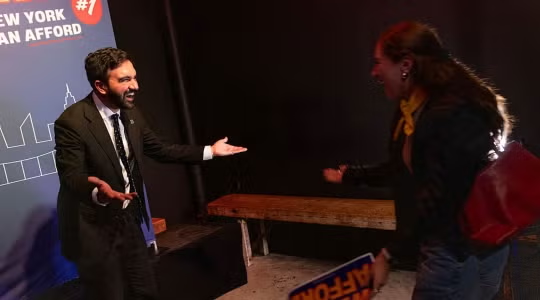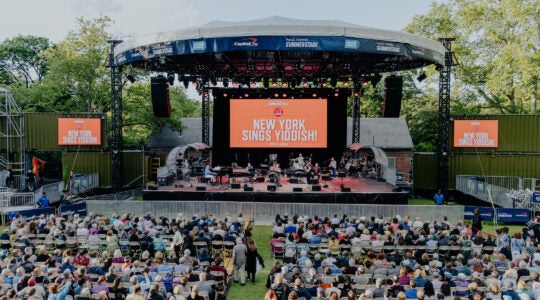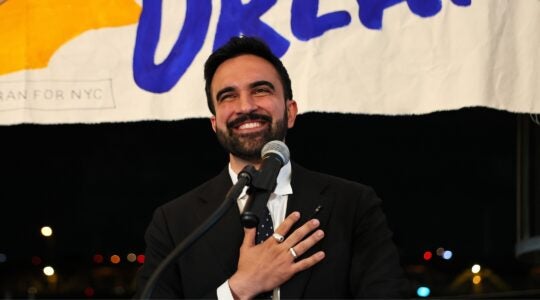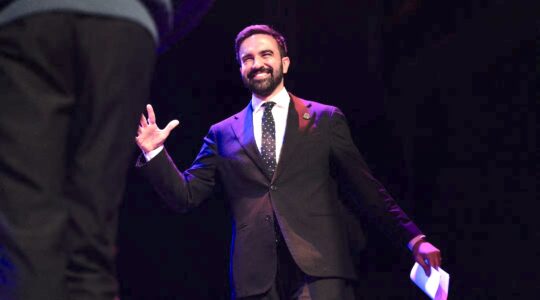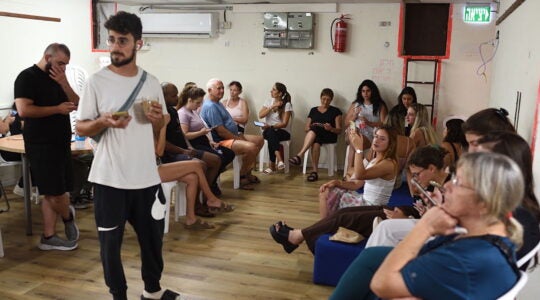Formal prayer, that musical and lyrical intersection between this world and the other, is as much science as art, as least for the cantor. There are rules, equations, let alone laws, but “most people don’t know how to daven anymore,” says Sherwood Goffin, “or they don’t know how to daven properly.”
That’s true even among the Orthodox, perhaps particularly among the Orthodox, whose synagogues are increasingly disinclined to hire professionally trained cantors — chazanim, or baalei tefillah, “masters of prayer.”
Goffin, Lincoln Square Synagogue’s cantor since 1965, honorary president of the Cantorial Council of America, and faculty member of the Belz School of Jewish Music, Yeshiva University’s cantorial school, says that of his 120 students per semester, “most are college students or rabbinical students who
want to know how to daven better, but serious [cantorial] students? Maybe 10. We used to tell students, ‘we can get you a job.’ Now we tell them, make sure you have a profession; if you’re lucky you’ll get a job, if only on the High Holidays.”
When Goffin was starting out in the early 1960s, he remembers that there were numerous professional cantors in Orthodox shuls: “Not everyone was perfect, but at least you heard davening.” Now, in the New York area, he counts “maybe 12.”
Without a chazan, “you have people getting up who think they know how to daven,” and not everyone does.
To preserve the audio Atlantis of how to properly lead services before it disappears under a sea of amateurism, the Belz School chose Goffin, a master of the craft, to record “Be a Baal Tefillah.” With more than 268 tracks, the recording demonstrates more than five hours of Shabbat davening, based on the Belz School curriculum. Also included is a small book of insights and explanations.
The project, in MP3 and MP3 CD audio format produced by the Davka Corporation, “is an accurate representation of how true Baalei Tefillah davened for centuries,” says Goffin. “It is nusach,” proper liturgical form, “as it ought to be.”
Let’s put this in terms most Jews can understand. The musical liturgy of Christmas Eve, seeking the ethereal stillness exemplified by “Silent Night,” has a different tonal requirement than does the jolly sleigh-bells Christmas music more appropriate to pre-Christmas shopping. It would be disturbing for a cultured Christian to walk into Midnight Mass and hear music befitting Rudolph’s nose at a time when the service tries to evoke the sense that “glories stream from heaven afar.”
Synagogue music at different moments of the year, even at different moments of Shabbat, has its own tonality and distinctions, sanctified by custom — even law, say many authorities — that Goffin says is being vandalized too often at services led by the well-intended but untrained.
Goffin, 66, who also is an instructor in Jewish folk music at the Belz School, says of niggunim, spiritual folk melodies, “You know how much niggunim mean to me. They are my life. However, when people lead davening solely on the basis of knowing a few niggunim, chagim [holidays] start to sound like Shabbat, and Shacharis Kedusha sounds like Musaf Kedusha. I’ve been in three shuls in the last few months where [the person leading services] did Shachris like Musaf and Musaf like Shachris because he simply didn’t know. The pre-Musaf Kaddish is one of the [musical properties cited] by the Maharil; you can’t halachically change it. Maybe in a Young Israel, decades ago,” when Young Israels were still being led by laity to the exclusion of professional clergy, “someone decided to use the [tune of the] Friday night Kaddish for the pre-Musaf Kaddish and people thought it was nice enough and are now doing it themselves, even though it specifically can’t be done,” according to centuries of precedent.
Rabbi Jacob Molin, the Geman-based scholar known as the Maharil, “realized, even in the 1300s, that foreign elements were creeping into the davening,” says Goffin. “Because of the Crusades, many Jews came to the Rhineland for safety, so the Maharil, who was a chazan as well, sought to find out how a particular piece of davening was done in the distant places where these refugees came from. If nine out of 10 said they did that davening in a specific way, well, that was it. He said it couldn’t be changed.”
The point of the Belz project, says Goffin, “is to spread that knowledge of nusach ha’tefillah,” the proper musical nuance and tone for each part of the davening. And yet, says Goffin, he was told by an official in a shul (not his own), “ ‘we don’t want nusach here, we just want niggunim.’ That’s the prevailing attitude, partially because of the lack of trained chazanim.”
Within nusach there is room for folk niggunim. For more than 40 years, after every Shabbat, Goffin meticulously writes down “every niggun I do,” when leading prayers at Lincoln Square, “so I don’t repeat within a seven-week cycle.” The “Be a Baal Tefillah” recording contains numerous niggunim, such as multiple versions for “Lecha Dodi” or “Kel Adon.”
But there are rules: “A niggun it has to match the proper mode — minor, major or any of the seven modes; it has to match the mood” of the specific prayer; and “it has to be music from a kosher source. The Shulchan Aruch [law code] says you shouldn’t use [even the tune of risqué] love songs,” such as “Erev Shel Shoshanim,” a 1960s Israeli song often used by lay cantors on Shabbat morning.
Goffin uses select niggunim composed by Shlomo Carlebach when he leads services but he shares the concern, increasingly being heard, that the so-called Carlebach minyans have obliterated nusach for the sake of a good niggun: “Shlomo, himself,” says Goffin, “never did a ‘Carlebach davening’ as it is now understood,” an unceasing series of Carlebach melodies from beginning to end of davening. “And Shlomo respected nusach.” When Shlomo (he preferred to be called by his first name) was singing a niggun while leading services, at an appropriate point he would return to the concluding verses of that prayer and sing it in the proper nusach.
“Shlomo,” says Goffin, “would be the first to say that nusach had to be preserved.”
Like everything else, muses Goffin, the circle will come around. “I hope this recording will be a beginning. Something is getting lost and we have to revive it.” n
Sample tracks from “How To Be a Baal Tefillah” can be heard at www.davka.com.
The New York Jewish Week brings you the stories behind the headlines, keeping you connected to Jewish life in New York. Help sustain the reporting you trust by donating today.
